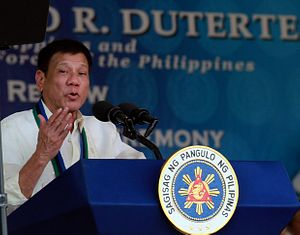The past year has been a wild ride for China-Philippines relations, pegged around developments in their dispute over reefs and waters in the South China Sea.
On July 12, 2016, after three years of deliberation, The Hague-based Permanent Court of Arbitration (PCA) gave its ruling on the South China Sea dispute between China and the Philippines — deciding in favor of the latter. The tribunal concluded, among other things, that there was no legal basis for China to claim “historic rights” to resources within the sea areas falling within the “nine-dash line” and that the Chinese vessels had unlawfully created a serious risk of collision by physically obstructing the Philippines’ vessels.
The PCA’s ruling was celebrated by Filipinos worldwide. Joining the celebration, Philippine Foreign Affairs Secretary Perfecto Yasay said, “The Philippines strongly affirms its respect for this milestone decision as an important contribution to ongoing efforts in addressing disputes in the South China Sea.”
Former President Benigno Aquino III, who initiated the case against China in 2013, called the ruling a victory for all and urged the international community to use the ruling to resolve other maritime disputes.
President Rodrigo Duterte, who succeeded Aquino and had assumed office on June 30, 2016, also initially welcomed the tribunal’s ruling and warned China to stay away from its territory or face the possibility of a “bloody” confrontation. However, Duterte stunned the world when he later sided with China by announcing an intention to divorce from the Philippines close ally, the United States. The ensuing strained relations between Manila and Washington were evident during the final months of the Obama administration.
Duterte said that he wanted to change Manila’s confrontational approach toward China. He expressed his doubt about the United States’ willingness to come to the support of the Philippines in the event of military confrontation with China over their competing territorial claims.
Duterte also said his country could not just resume control of the resource-rich Scarborough Shoal from Beijing despite the PCA ruling, as the Philippines’ military forces were no match for Beijing’s powerful forces.
At that time it was widely assumed that Duterte’s change of policy was triggered by the oil reserves found in the hotly contested Scarborough Shoal, one of the many disputed islands, reefs, and shoals in the South China Sea between China and the Philippines. The World Bank estimates that the South China Sea holds oil reserves of at least seven billion barrels and an estimated 900 trillion cubic feet of natural gas, which offer tremendous economic opportunity for the littoral countries. It was believed that Duterte was considering tapping some of those reserves in a joint partnership with China.
But in December, Manila changed its tune again, and filed a protest with the Chinese embassy over Beijing’s reported military buildup on the islands and reefs in the contested Spratly Islands in the South China Sea. The protest came one month after Duterte promised to respect defense treaties with the United States, despite Duterte’s publicized embrace of Beijing and divorce from Washington.
Duterte’s flip-flop on the South China Sea could have been motivated by several different factors, including China’s increasingly assertive stance toward the disputed areas, the Trump administration’s announcement that it would contain Beijing in the South China Sea, and, more importantly, a recent survey that showed 84 percent of Filipinos want Duterte to assert his country’s rights over its territories in the South China Sea.
The relations between Manila and Beijing openly began to simmer again when Yasay, while chairing a meeting of foreign ministers of the Association of South East Asian Nations (ASEAN), said on February 21 that the regional bloc unanimously expressed its “grave concerns” about China putting weapon installations on its man-made islands in the Spratlys.
The announcement apparently angered the Chinese leadership, which led to the last-minute postponement of Commerce Minister Gao Hucheng’s visit to the Philippines, which was scheduled for February 23. The visit was aimed at signing about 40 joint deals worth billions of dollars. The Chinese government, which said Yasay’s remarks were “baffling and regrettable,” has since announced the appointment of a new minister to replace Gao, as part of a reshuffle ahead of a crucial Communist Party meeting later this year.
It is no secret that Duterte is keen to tap China for loans, tourists, and infrastructure but his constant changes of policy on the South China Sea is a set-back. It’s also complicating things for the United States, which wants to play the role of power balancer. The shifting Philippine position is equally unhelpful for forming a strategic partnership among ASEAN member states. One of the founding principles of ASEAN is to resolve disputes peacefully through a consensus vote, which usually happens after rounds of informal consultations. If Manila’s position changes every few months, those consultations will be much more complicated.
While Duterte would know best the rationale behind the recalibration of his policy vis-à-vis the South China Sea, it is evident from recent developments that his multi-pronged approach to simultaneously befriend China, the United States, and ASEAN allies is not yielding the desired benefits, at least at the moment.
Dr. Nehginpao Kipgen is Assistant Professor and Executive Director of the Center for Southeast Asian Studies, Jindal School of International Affairs, O.P. Jindal Global University. His writings (books and articles) have been widely published in over 30 countries in five continents – Asia, Africa, Australia, Europe, and North America.
































